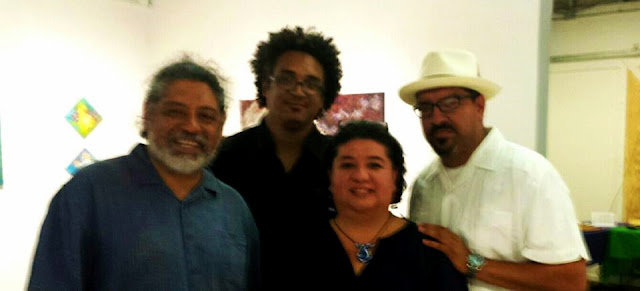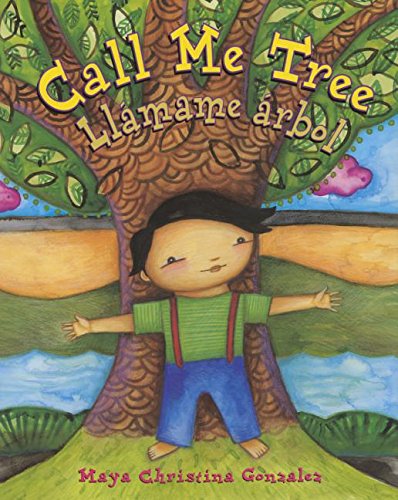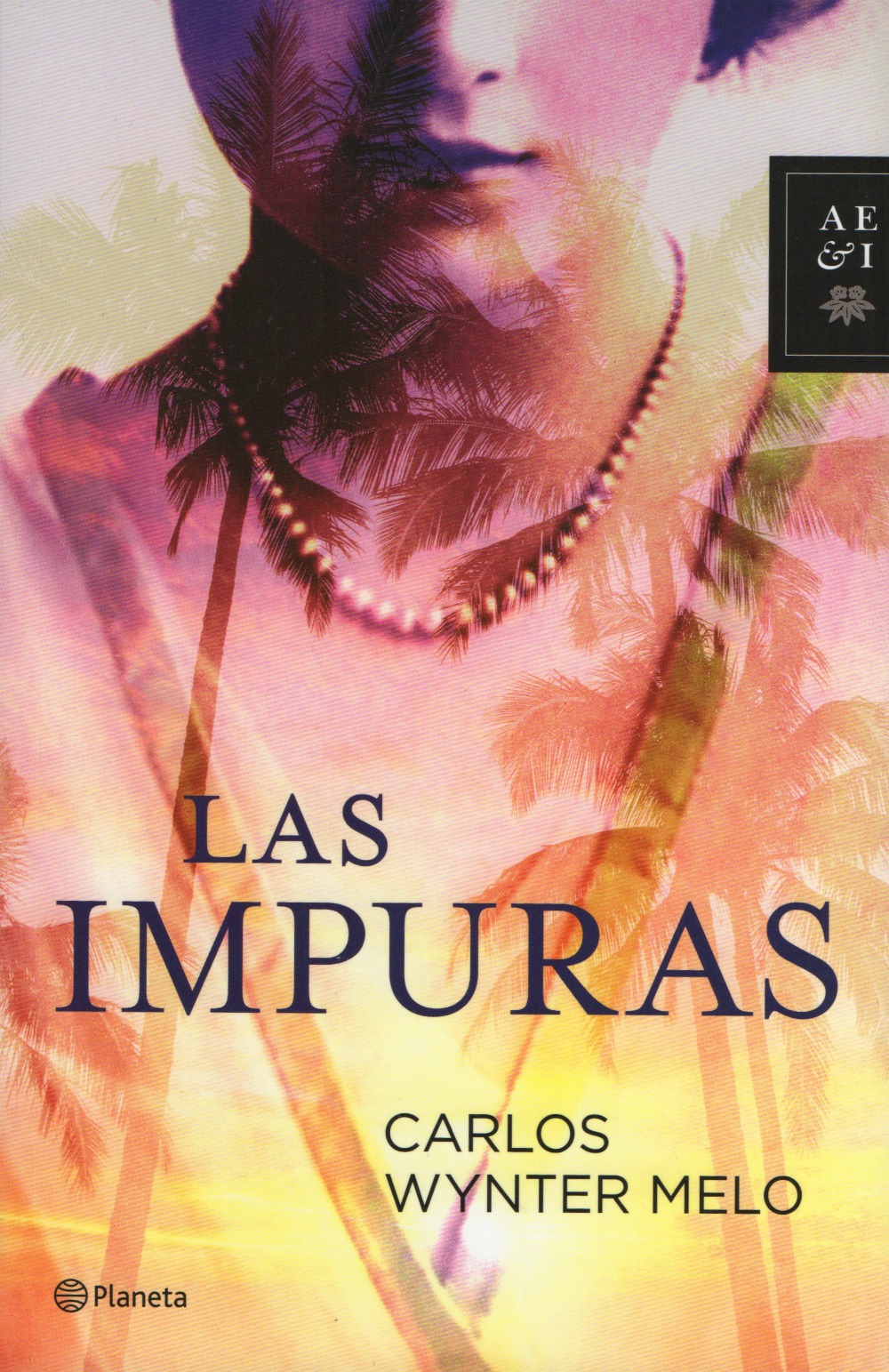Michael Sedano
Some weeks bring art gallery openings, some bring poetry readings, others bring reunions and activism. Some weeks nothing, others, like the one recently completed, come with a plethora of fun, the emphasis on the U in fun.
Happy Birthday to an Old Cultural Warrior
 |
| Rosalio Muñoz and Mita Cuaron at Muñoz' birthday celebration. Muñoz and Cuaron were in the leadership that organized the Chicano Moratorium of August 29, 1970, along with other events. |
These were big, wonderful events. But for me, the best part of the weekend occurred in a quiet moment with a trio of former classmates that brought me a rare gift.
I was bidding my despedidas to the hosts of Rosalio’s pachanga, Terry and David Trujillo, when a man told me “you were my teacher at Cal State.” Sadly I didn’t remember Ruben Vargas exactly. For several memorable years in the 1980s, Terry and David and I were members of Teatro a la Brava. David wrote actos. Terry was a leading actor. I was the director.
“We had an argument about downtown LA,” Ruben remembered. I liked the central city area around Broadway and 7th and urged students visit for intercultural immersion. I celebrated the place, Ruben wanted me to focus on the deprivations. “There are a lot of problems down there,” he insists and I agree. Then the highlight of an old speech coaches life.
I met Terry as a member of a public speaking class, a GE requirement. Terry told her nieces at the registration table, "this was my teacher," then complimented me that I taught her to be comfortable in public speaking, even when she’s nervous.
Back in the 1980s when Terry was a freshman, professor me would have run through his standard communication-apprehension theory and coaching session. Even today the c-a lessons emerges as a reflex.
“Nervousness is a good thing,” I start the rote respose and Terry makes my day, echoing the lesson she heard back in the 80s, “because if you’re not nervous it means you don’t care.” I give Terry a big hug while silently exulting to myself "it worked!"
 |
| top, David Trujillo, Terry Trujillo, Ruben Vasquez |
With Terry’s words echoing in my heart I make my way to Avenue 50 Studio, getting there early to ensure parking in the lot.
Bluebird reading presents : Homage to Bukowski
Michael Sedano
The same sensibility that informs hard-boiled fiction inheres in Charles Bukowski’s work, except the wino poet replaces a sucker punch to the gut with a knee to the emotions and a sharp stick to the funny bone. In poetry and prose, that was the point in Bluebird Reading Series’ Homage To Bukowski, concluded Sunday at Highland Park’s Avenue 50 Studio.
 |
| Kym Ghee, John Martinez, Jim Marquez, Felicia Gomez Verdin, Tomas Benitez |
Bukowski was honored more in the breach than the observance, as most performers honored the late artist with their own writing under the influence, along with a nice set by Felicia Gomez Verdin featuring Bukowski’s work, and host-emcee Jessica Ceballos’ inaurgural recitation of “Bluebird,” Ceballos’ inspiration in founding the readings series.
there's a bluebird in my heart that
wants to get out
but I'm too clever, I only let him out
at night sometimes
when everybody's asleep.
I say, I know that you're there,
so don't be
sad.
then I put him back,
but he's singing a little
in there, I haven't quite let him
die
and we sleep together like
that
with our
secret pact
and it's nice enough to
make a man
weep, but I don't
weep, do
you?
For the writers on the program, they do their weeping onto their manuscripts. Their tears come off the page as personal narratives, the words with sharp edges that hurt so hard one has to laugh, grin and bear it. That was Tomas Benítez’ QED to open the readings.
 |
| Tomas Benitez |
Benitez led off the afternoon with a set of beautifully crafted expressions that balance a satyr’s conscience against abruptly changing situations. In one, the poet has lost his woman, his six-figure job, and he’s broke. Wistfully, a poet recalls the shape and allure of his former wife’s leg, the perfection of it, then comes a heel stomp on the funny bone, “too bad it was yours.” The SRO audience let Benitez, who produced the event, continue well past his allotted time. He dug it, we dug it.
 |
| Felicia Gomez Verdin |
if you have to sit there and
rewrite it again and again,
don't do it.
if it's hard work just thinking about doing it,
don't do it.
if you're trying to write like somebody
else,
forget about it.
John Martinez tells the house he forgot about it for a number of years, but complying to his late brother Victor Martinez’ wish that John pursue writing again, he has.
 |
| John Martinez |
With Bukowski, Martinez shares a lust for talking about reality as he sees and lives it. Except where Bukowski lays bare a mind at the edge of incipient violence—will it be the bluebird or the mean drunk?--Martinez is likely to damn his consequences while baring unsalved wounds for which the balm is the poem.
 |
| Kym Ghee |
Ghee discovers one of those unknown novelists found in a thrift store or a hoarder’s attic. She travels an hour north to visit her imagined genius. She meets up with an agoraphobic hypochondriac uninterested in the past. Worse, the man’s vengeful landlady makes her mission in life to tear the sweet young thing a new asshole right between the eyes for being all dreamy-eyed about the great author. Mean for the sake of being mean.
if it doesn't come bursting out of you
in spite of everything,
don't do it.
unless it comes unasked out of your
heart and your mind and your mouth
and your gut,
don't do it.
 |
| Jim Marquez makes eye contact 3 out of 4 frames |
A high energy reader, Marquez’ writing explodes with drama and aggression. And, à la Bukowski, a lot of fucking sexual tension. A wino tío introduced me to Bukowski’s world so I would know to avoid it. From what I hear of Marquez’ Los Angeles, I’m glad I’m from over here, a homebody. It’s hard out there. Or it’s hard being the fictional Jim Marquez.
When the “filthy speech movement” arose parallel with Berkeley’s free speech movement in the 60s, poet Lenore Kandel proclaimed that the beauties of fucking makes the word inappropriate as interjection, intensifier, or curse. “May you not be fucked,” Kandel said, was among the worst things you could wish upon a person.
Kandel’s ethic had its five minutes’ fame and conscientious gente went ahead tossing out the standard seven-letter gay repartee without a hiccup. Still, I recommend Kandel’s sensibility to Jim Marquez.
Until Marquez took the Bluebird seat I hadn’t heard so many gratuitous “fucks” since the Army, though a pair of skateboarders came close one day on the bus. I wonder if Marquez goes home for thanksgiving dinner and, like the apochryphal soldier, “Mom, would you please pass the fucking mashed potatoes?”
 |
| Felicia Gomez Verdin makes eye contact |
Last week I shared news that USC’s Digital Library now archives the video recorded performances of the poets and other writers who accepted an invitation to 2010’s Festival de Flor Y Canto. Yesterday • Today • Tomorrow. Like the 1973 Festival de Flor Y Canto that launched the floricanto movement, those were important readings and it was unthinkable not to have the record that now stands alongside the videos from 1973.
Jesus Treviño, creator of Latinopia, directed the documentation for the reunion floricanto. Latinopia will be a place to view snippets of performances with fast-loading convenience. Treviño limits each video segment to three minutes. USC’s Digital Library together with Latinopia’s ever-growing library—Treviño updates weekly--will be a visual index to writers of chicano literature reading in their own voice.
The Bluebird Homage to Charles Bukowski is an important literary event, too. It was recorded. When that recording becomes public, La Bloga will make sure to provide a link. Viewers will see how tough it is to read and communicate at the same time. Writers who do do it, owe their work, and the audience an effective reading, the best reading the writer’s ever performed. An early goal is ongoing improvement of eye contact.
 |
| Although this set illustrates Jim Marquez denying his audience eye contact, portraits for each reader would show the same. Eye contact is a universal opportunity for improvement. |
Beside selling more books, this is an eye contact work-around. Writer’s eyes on the page, audience’s eyes on the page: eye contact irrelevant. Maybe every now and then you’ll look up together, make eye contact, and recognize what you people are doing here.
 |
| Kym Ghee can read at a glance but her facing audience can't see her |
Jim Marquez presentation style is as energetic and edgy as his fiction. He’s comfortable in the narration, using voice and gesture to imbue key words and passages with power. What Marquez doesn’t do as well is establish a bond with the listener through more frequest moments away from the text.
 |
| John Martinez makes eye contact, establishes a bond with audience. |
I would love seeing that energy he directs at that computer screen turned to the expectant house. Mejor for the writer, a break from the text to the seats is feedback, both to performer and page: what’s working? what do they want more of? Do they get it? Should I skip to the end?
“Old men love to give good advice. It consoles them for the fact they no longer can set a bad example.” Except for eye contact. It’s an expectation that doesn’t get old and the benefits so dramatic writers put a “kick me” sign on their back for a week after discovering the job satisfaction that comes with an eye contact personal performance best. So, if you want to read your stuff to other people, and you can’t find ways to make more eye contact, don’t do it.
Avenue 50 Studio • 131 N. Avenue 50 • Highland Park CA 90042 • 323-258-1435
www.avenue50studio.org
The Bluebird Reading series is a component of Avenue 50 Studio's literary arts programming. Avenue 50 Studio is supported in part by the Historic Highland Park Neighborhood Council, the City of Los Angeles Department of Cultural Affairs, the Los Angeles County Arts Commission, and the California Community Foundation.
Altadena Poetry Summer Series at Coffee Gallery Backstage
 |
| Toti O'Brien and half the audience |
 |
| Listeners enjoy the air-conditioned backstage galley and intimate interaction with the readers |
ISBN-13: 978-0692399781)
The day’s lineup included two poets I’d photographed at other venues—Ricky Luv and Toti O’Brien, along with three seasoned writers new to my ear and lens-- Gloriana Casey, Mina Kirby, and Mary Monroe. The highlight of the day was the way Gloriana Casey addresses manuscript conundrum readers face with each trip to the lectern.
 |
| Mina Kirby |
 |
| Ricardo Lira Acuña, Ricky Luv |
 |
| Gloriana Casey |
 |
| Gloriana Casey prepares her readings for eye contact and legibility |
The backstage gallery provides excellent amplification. Microphone stands lure readers into planting themselves at the mic where they hold onto home base like their shoes were nailed to the floor. Speakers may swivel their neck or pivot at the waist to see and address the whole audience, but are as likely to ignore one side of the house.
 |
| Mary Monroe makes contact with both sides of the center aisle |
The next event at the Coffee Gallery Backstage is Saturday, July 18, featuring poets laureate from Altadena, North Hollywood, and Sunland-Tujunga.
Avenue 50 Studio Rocks Punks
 |
| Photographer Louis Jacinto likes his 4tych of Alice Bags |
In the main gallery, Roberto Gutíerrez paid homage to the up-for-demolition Sixth Street Bridge spanning the cement channeled LA River. Gutierrez’ work in the background of the Bluebird readers add just the right shades of color and design to the portraits.
 |
| Roberto Delgado is happy to take a foto with a young artist and his brother. |
The wall of Alice Bag portraits held interest for anyone passing through from the refreshments table to the main gallery. La Bloga friend The Good Mexican Girl paused for a snap of herself with Alice Bag. Reina Alejandra Prado joined 2010's reunion floricanto; her Santa Perversa reading is here.
 |
| Reina Alejandra Prado with Alice Bags by Louis Jacinto |
Bits and News
Casa de Colores Call for Ideas: Poet Laureate
US Poet Laureate Juan Felipe Herrera has a call out for ways the laureate can build a magnificent Casa de Colores for the entire nation. Here's Juan Felipe's announcement:
Hey peoples -- Can you send me suggestions for rolling out projects under the banner of CASA DE COLORES, our National Laureate project starting September.
I definitely want a lot of participation with Library of Congress, with each other, across all communities, a lot of voices, languages and abilities, as well as translations of work into all languages, spoken word choruses -- just to give you an idea... then I'll see if I can incorporate your ideas into CASA DE COLORES, our HOUSE OF COLORS -- let's jam a little, brain storm...thanks mucho!
Contract Herrera with your ideas via his Facebook page, or via La Bloga.
Bits and News
Adult Stepchildren's Help Sought
La Bloga friend Dawn O. Braithwaite of the University of Nebraska, Lincoln writes:
So many focus on the negatives in stepfamilies, rather than the positives. My name is Dawn O. Braithwaite from the Department of Communication Studies at the University of Nebraska-Lincoln. We are studying turning points and communication in the relationships of adult stepchildren who have an overall positive relationship with their stepparent.
Please help us find adult stepchildren to take part in an interview with us. We are looking for adult stepchildren age 25 or older with an overall positive relationship with their stepparent. We are looking for stepfamilies that started no less than four years ago and at an age stepchildren would remember the start of the family. The parent and stepparent are currently living together or are married.
Those willing to participate should contact Jordan Allen jordan.allen75@huskers.unl.edu or me dbraithwaite@unl.edu and we will send you more information. Thank you!
Please let the researchers know you heard about the opportunity via La Bloga.
Mariposa Poetry Workshop Applications Now
La Bloga friend Maritza Rivera, a woman recently retired from the world of work, opens registration for the fourth annual poetry workshop she sponsors in Pennsylvania's Catoctin Mountains. Rivera writes:
The 4th Mariposa Poetry Retreat builds community among poets and writers and provides them the time and space to focus on their work in a serene and beautiful setting away from the pressures of daily life.
The retreat promotes a safe and instructive environment that addresses the creative challenges faced by writers of all genres. The 2015 weekend retreat will take place at the Capital Retreat Center in Waynesboro, PA from Friday, October 2nd to Sunday, October 4th and is open to writers 18 years of age and older.
Email Maritza Rivera or visit www.MariposaPoetry.org for registration forms and details.
Thank you for visiting La Bloga. Please share your comments and observations by clicking the Comments link below. Be sure to click the "email follow-ups" link when you comment.
Barrio Writers Finds You Can Go Home Again
La Bloga friend (and 2010 floricanto reader) Sarah Rafael Garcia has created an impressive legacy in the Barrio Writers organization. Expanding into Texas when Garcia attended graduate school in the state, the founding term in California's Orange County grew moribund. No more.
Click here to read about this important development:
http://www.barriowriters.org/2015/07/barrio-writers-returns-home-to-santana.html

























































































